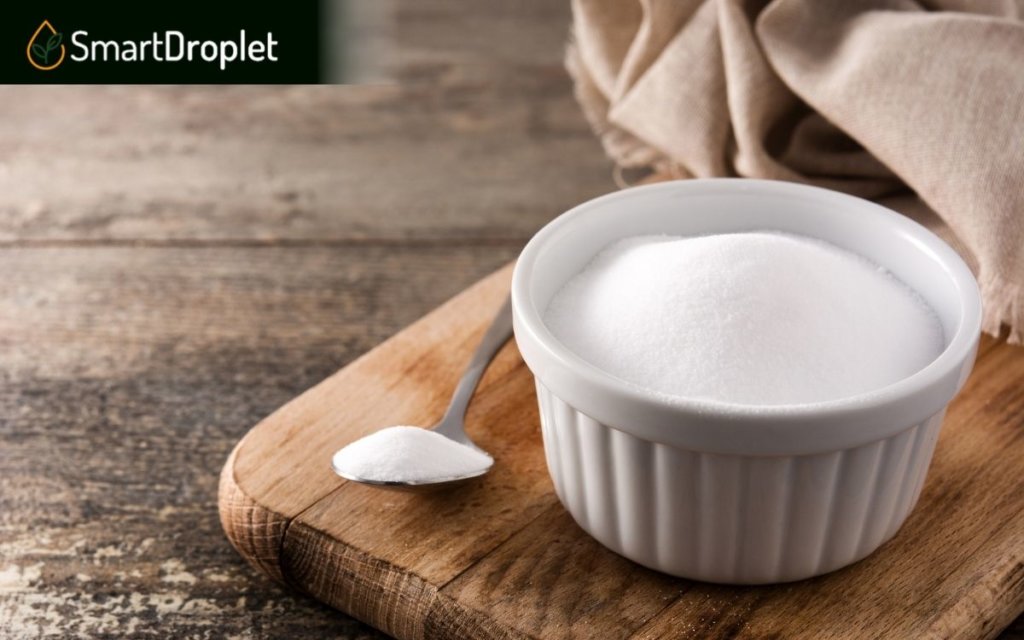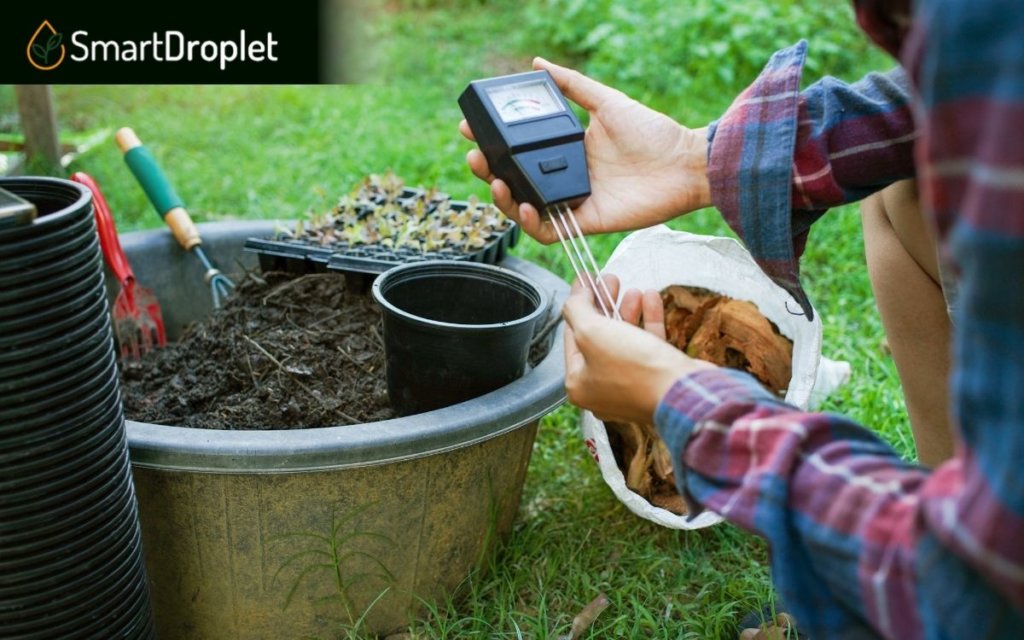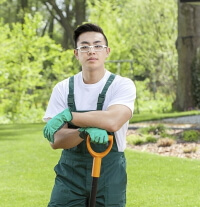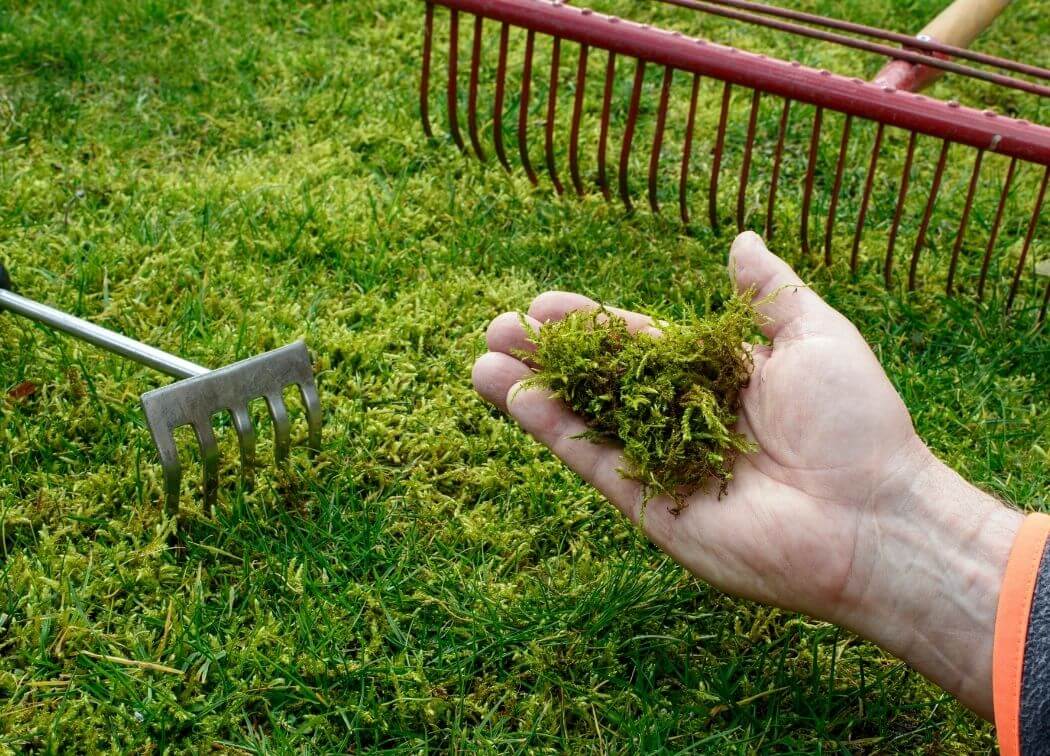At first glance, moss may seem like a harmless plant that grows on rocks, grass, or near other plants.
But sometimes, moss can prevent water and nutrients from entering the soil.
Existing moss is also a sign of damaged soil and, in turn, damaged plants!
Luckily, there are two easy ways to get rid of lawn moss; BAKING SODA and HERBICIDES! There are also alternative methods, such as using BLEACH, VINEGAR or DETERGENT solutions. These methods are less commonly used, but work just as well in killing moss!
In this lawn care guide, you will learn to prevent moss from regrowing again!
Two Main Ways to Kill Moss
The two main ways of getting rid of unwanted moss are organic and chemical.
Let’s go through each one!
1. Using Baking Soda

The organic method involves creating your solutions with ingredients that kill lawn moss in your lawn.
One of the most effective compounds that get rid of BAKING SODA!
Baking soda kills moss quickly and works great against moss growth and even small patches of crabgrass.
The best part is that it is NATURAL and HARMLESS to the surrounding grass or nearby trees.
All you have to do is mix baking soda with water in a spray bottle and spritz away! The minimum quantity is ONE TABLESPOON of baking soda with ONE GALLON of water.
This quantity may be more depending on how much lawn moss is present. After a day or two, rake the dead moss off the lawn to prevent it from regrowing.
You can also apply dish soap mixed with water, repeat the same process, and have similar results!
2. Using Herbicides
Another common way to get rid of living moss is by using HERBICIDES to target the living plant.
Most herbicides are made with iron sulfate or iron-based, an effective moss killer.
Some moss killers act as fertilizers, which keep the green grass and soil healthy!
HOWEVER! Using herbicides is also quite risky.
Not all herbicides will work the same way in killing moss as some herbicides that kill most plant types FAIL to kill moss.
Additionally, it is also not advisable to use iron sulfate on its own as it is a strong chemical that could harm your grass or lawn.
Other Ways to Get Rid of Lawn Moss
Depending on your resources, there are some less common ways to get rid of moss. These methods work just the same in treating moss!
Bleach
Bleach is another effective ingredient that can kill moss quickly!
All you have to do is mix around 0.5 cups (125 ml) of bleach with one gallon of warm water.
You want the bleach solution to be as diluted as possible so that the nearby garden plants and surfaces will remain safe.
Bleach makes a good moss killer but can also stain concrete or other surfaces and cause harm to nearby plants.
Vinegar
If you want a more harmless solution, you can use a vinegar solution!
The solution consists of one part vinegar and two parts water.
Spray the vinegar and water mixture on all the moss, and it should die or turn brown over 24 hours.
Vinegar is generally harmless and safe around other plants but can cause discoloration to various surfaces.
Scrubbing With Detergent
This method requires a little more physical effort but is still effective nonetheless!
You can remove moss by applying soap or detergent on the moss and scrubbing it off with a brush or broom.
Unlike bleach or other compounds, detergent is chemical-free and harmless to surrounding plants.
NOTE: Alive or actively growing moss may be harder to get rid of than dead moss.
How to Prevent Moss from Resurfacing
Now that you have gotten rid of the moss, it’s time to take preventive measures.
Here are some tips preventing moss from regrowing!
1. Checking Soil pH Levels

Moss growing could be a result of a low soil pH level.
The ideal pH level of soil should be around 6 and 7. This pH level will inhibit moss growth and leave your soil healthy.
You can use a soil meter to check the pH level.
Moss prefers acidic soil, so if it is too acidic (lower than 6 pH), you can add lime or bone meal to make it more basic or alkaline.
Likewise, if the soil is too basic, a good, rich compost should do the trick!
NOTE: The best time to apply the lime would be between early fall and early spring.
2. Fixing Drainage
Excess moss could also be caused by poor drainage.
Because moss thrives in wet conditions, it could be that there is excess moisture or compacted soil due to fall rains or warm winter rains.
You can improve soil drainage by applying organic compost. Doing so will also decrease the chances of root rot and healthy grass.
3. Reduce Shade
Moss doesn’t like the sun!
Because of this, you will see that moss grows more in shady areas. That’s also why you see a lot of moss species in dense forests and other dim places.
You can control moss by reducing shade and allowing more sunlight to shine through!
4. Improve Aeration
You can improve aeration by using a pitchfork to create holes in the grass or ground for air to pass through, removing moss quicker.
Conclusion
We hope this lawn care guide helped teach you how to treat moss and prevent future lawn moss from growing!
Remember to maintain a healthy lawn so that controlling moss would no longer be a problem!
Frequently Asked Questions
Let’s go over some additional questions you might have on treating moss and killing them.
-
What Is Moss Made Of?
Mosses are made of rhizoids, which look like strands of hair, which take in the nutrients and anchor them to rocks, soil, and alike.
They are primitive plants that lack vascular tissue, so they do not transport water the same way most advanced plants do.
-
How Does Moss Spread?
Moss spreads through SPORES carried by the wind, rain, or other moving waters. There is a greater chance moss will grow in areas with unhealthy plants and soil.



